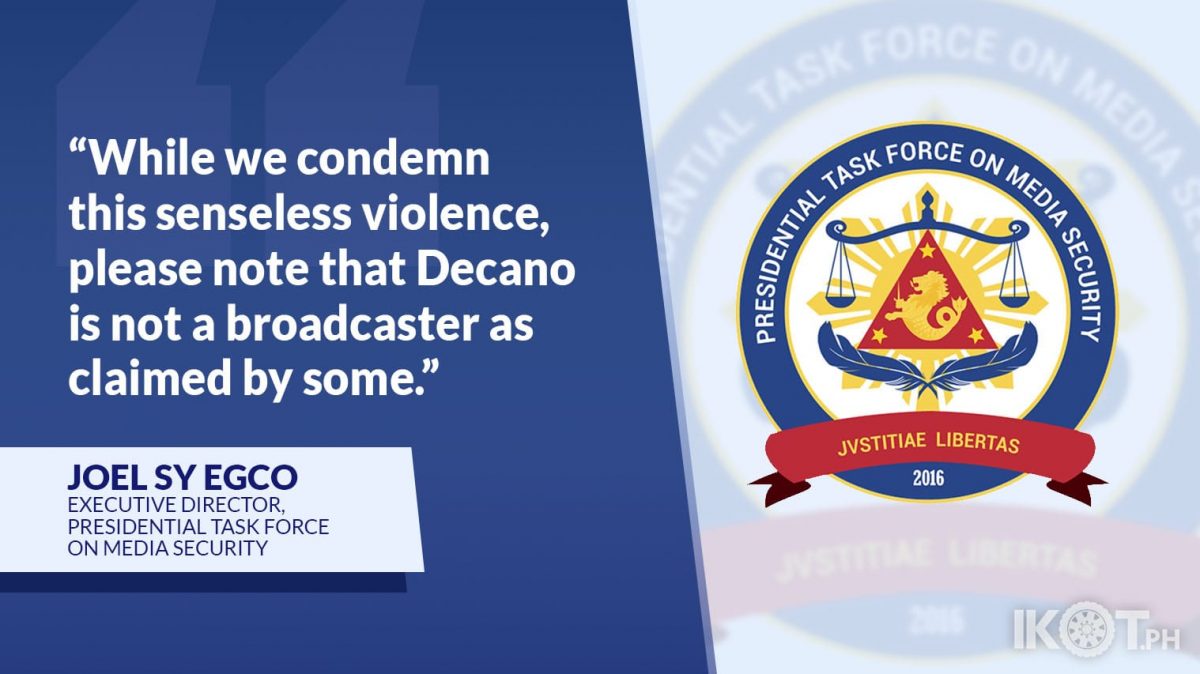Authorities are hot on the trail of the alleged killer of John Michael Decano, a massage therapist and beautician who was killed more than a year ago and who was erroneously referred to as a broadcaster.
Presidential Task Force on Media Security (PTFoMS), through its Executive Director, Undersecretary Joel Egco, recently released to the public a copy of the warrant of arrest issued by Judge Maximino Ables of the Regional Trial Court of Sorsogon City on February 11, 2020 against suspect Lendrick Tamparia, of Palanas, Masbate, for the crime of murder. No bail was recommended.
The 35-year-old Decano, also known as Jelly/Jelai, was killed on January 29, 2019.
The National Union of Journalists of the Philippines erroneously said that Decano was a broadcaster.
The unverified claim might have led the United Nations Educational, Scientific and Cultural Organization (UNESCO) to include the victim in its infamous Observatory of Killed Journalists, casting doubts on the integrity of its data, PTFoMS lamented.
The Director General, Audrey Azoulay, went as far as issuing a statement condemning the killing, claiming that it violated press freedom.
“There is really a big disconnect between UNESCO’s list versus the facts on the ground.”
“There is really a big disconnect between UNESCO’s list versus the facts on the ground. Most of its information on Decano is hearsay at best as the same were merely culled from online sources, particularly from disgruntled groups who have nothing better to do but to vilify the government for their own selfish ends,” PTFoMS said in a new release.
A thorough probe by the Philippine National Police into the background of the victim showed that he was an employee of a local salon where he was killed.
Maj. Jose Micheal Aurelio of the Sorsogon City Police Station, in response to a formal inquiry from the Presidential Task Force, reported that “after (a) series of thorough investigation, please be informed that the victim John Michael Decano is not a media practitioner but a massage therapist and a beautician who was found dead inside his workplace on January 29, 2019.”
“While we condemn this senseless violence, please note that Decano is not a broadcaster as claimed by some. I call on groups representing journalists to strictly adhere to the code of ethics instead of making bare allegations. They should have the decency to at least be factual,” Sy Egco said.
“I dare officials of UNESCO to look into this case themselves.”
“It is unfortunate that UNESCO once again was swayed by false information peddlers without knowing the actual facts. Is this how UNESCO conducts its investigations? I dare officials of UNESCO to look into this case themselves. Otherwise, UNESCO must remove Decano from its list,” the Palace official pointed out.
He added they will formally request UNESCO to update its list with these new findings.
In a recent report released by UNESCO, the Philippines was cited as one of the countries in the world that have made significant strides in protecting journalists.
UNESCO’s 2020 Director-General Report on the Safety of Journalists and the Danger of Impunity stated that “significant progress was made” by the country in the case of the 2009 Maguindanao Massacre, pointing out that in 2019, a court convicted 43 individuals including the masterminds behind the attack.
The UNESCO report also emphasized that the Philippines has put up measures to prevent crimes against journalists and established specific bodies dedicated to ensuring the prosecution of crimes against media workers.
PTFoMS was created by President Rodrigo Duterte in 2016 to specifically safeguard press freedom by protecting the life, liberty and security of media workers, the first of its kind in the world.
In 2018, the Philippines was removed by French-based Reporters Without Borders from its list of most dangerous countries in the world for journalists.
By 2020, the Philippines was declared as the most improved country in the world by the US-based Committee to Protect Journalists in its annual impunity index.

